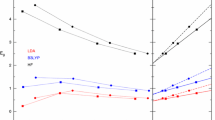Abstract
The structure and electrical properties of open carbon nanotube with chirality (4,4), consisting of 5-15 segments, are calculated within four quantum chemical models: AM1, PM3, LSDA/3-21G*, and B3LYP/6-31G. Size effects and the effect of the model choice on the geometry, energy, enthalpy and Gibbs energy of the formation (atomization), Mulliken atomic charges, polarizability, and predicted adsorption properties of nanotubes are discussed.
Similar content being viewed by others
References
S. Iijima, Nature, 354, 56 (1991).
R. H. Baughman, A. A. Zakhidov, and W. A. de Heer, Science, 297, No. 5582, 787 (2002).
P. N. Dyachkov, Electronic Properties and Application of Nanotubes [in Russian], Binom Lab. Znanii, Moscow (2011).
R. Saito, Physical Properties of Carbon Nanotubes, Imperial College Press, London (1998).
M. V. Kharlamova, Usp. Fiz. Nauk, 183, No. 11, 1145 (2013).
E. R. Badamshina, M. P. Gafurova, and Ya. I. Estrin, Usp. Khim., 79, No. 11, 1027 (2010).
V. I. Irzhak, Usp. Khim., 80, No. 8, 819 (2011).
T. McNally and P. Potschke, Polymer Carbon Nanotube Composites: Preparation, Properties and Applications, Woodhead Publishing, Cambridge, UK (2011).
S. Hou, Z. Shen, X. Zhao, et al., Chem. Phys. Lett., 373, 308 (2003).
S. Han, M. H. Lee, and J. Ihm, Phys. Rev. B, 65, No. 8, 085405 (2002).
K. Tada and K. Watanabe, Phys. Rev. Lett., 88, No. 12, 127601 (2002).
J.-M. Bonard, T. Stockli, F. Maier, et al., Phys. Rev. Lett., 81, No. 7, 1441 (1998).
S. Han and J. Ihm, Phys. Rev. B, 61, No. 15, 9986 (2000).
T. Yumura, K. Hirahara, S. Bandow, et al., Chem. Phys. Lett., 386, 38 (2004).
A. De Vita, J.-Ch. Charlier, X. Blasee, et al., Appl. Phys. A, 68, No. 3, 283 (1999).
K. A. Dean and B. R. Chalamala, J. Appl. Phys., 85, No. 7, 3832 (1999).
E. G. Rakov, Nanotubes and Fullerenes [in Russian], Logos, Moscow (2006).
D. Lovall, M. Buss, E. Grangnard, et al., Phys. Rev. B, 61, No. 8, 5863 (2000).
Z. Q. Xue, W. M. Liu, S. M. Hou, et al., Mater. Sci. Eng. C, 16, Nos. 1/2, 17 (2000).
W. Liu, S. Hou, Z. Zhang, et al., Ultramicroscopy, 94, Nos. 3/4, 175 (2003).
A. Solhy, B. F. Machado, J. Beauso-leil, et al., Carbon, 46, 1194–1207 (2008).
N. Pierard, A. Fonseca, Z. Konya, et al., Chem. Phys. Lett, 335, 1 (2001).
G. Maurin, I. Stepanek, P. Bernier, et al., Carbon, 39, 1273 (2001).
G. Zhou, W. Duan, and B. Gu, Phys. Rev. Lett., 87, No. 9, 095504 (2001).
M. J. S. Dewar, E. G. Zoebisch, E. F. Healy, et al., J. Am. Chem. Soc., 107, No. 13, 3902 (1985).
J. J. P. Stewart, J. Comp. Chem., 10, 209 (1989).
A. D. Becke, Phys. Rev., 38, No. 6, 3098 (1988).
C. Lee, W. Yang, and R. G. Parr, Phys. Rev. B, 37, No. 2, 785 (1988).
M. J. Frisch, G. W. Trucks, H. B. Schlegel, et al., Gaussian 09, Gaussian, Inc., Wallingford CT (2009).
E. V. Butyrskaya, Computer Chemistry: Theory Principles and Gaussian and GaussView Program Operation [in Russian], Solon–Press, Moscow (2011).
A. Hirsch and O. Vostrowsky, Top. Curr. Chem, 245, 193 (2005).
L. N. Sidorov and Yu. A. Makeev, Soros Obraz. Zh., 6, No. 5, 21 (2000).
E. D. Graifer, V. G. Makotchenko, A. S. Nazarov, et al., Usp. Khim., 80, No. 8, 784 (2011).
D. C. Elias, R. R. Nair, T. M. G. Mohiuddin, et al., Science, 323, No. 5914, 610 (2009).
Y.-H. Li, J. Ding, Z. Luan, et al., Carbon, 41, No. 14, 2787 (2003).
Author information
Authors and Affiliations
Corresponding author
Additional information
Translated from Zhurnal Strukturnoi Khimii, Vol. 57, No. 4, pp. 688-696, May-June, 2016.
Rights and permissions
About this article
Cite this article
Butyrskaya, E.V., Zapryagaev, S.A., Nechaeva, L.S. et al. Effect of the calculation method and the basis set on the structure and electrical properties of (4,4) carbon nanotubes with different lengths and open ends. J Struct Chem 57, 649–657 (2016). https://doi.org/10.1134/S002247661604003X
Received:
Revised:
Published:
Issue Date:
DOI: https://doi.org/10.1134/S002247661604003X




